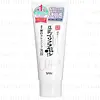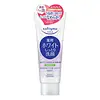What's inside
What's inside
 Key Ingredients
Key Ingredients

No key ingredients
 Benefits
Benefits

 Concerns
Concerns

 Ingredients Side-by-side
Ingredients Side-by-side

Dipotassium Glycyrrhizate
HumectantWater
Skin ConditioningMyristic Acid
CleansingGlycerin
HumectantPotassium Hydroxide
BufferingPalmitic Acid
EmollientStearic Acid
CleansingSorbitol
HumectantPEG-7 Glyceryl Cocoate
EmulsifyingGlyceryl Isostearate
EmollientLauric Acid
CleansingMilk Ferment
Skin ConditioningGlycine Soja Extract
Skin ConditioningMagnesium Ascorbyl Phosphate
AntioxidantButylene Glycol
HumectantC18-22 Alkyl PEG-25 Methacrylate/Diethylaminoethyl Methacrylate Copolymer
Emulsion StabilisingPotassium Cocoyl Glutamate
Alcohol Denat.
AntimicrobialGlycosyl Trehalose
Emulsion StabilisingSodium Toluenesulfonate
Sodium Lauroyl Methylalanine
Dipotassium Glycyrrhizate, Water, Myristic Acid, Glycerin, Potassium Hydroxide, Palmitic Acid, Stearic Acid, Sorbitol, PEG-7 Glyceryl Cocoate, Glyceryl Isostearate, Lauric Acid, Milk Ferment, Glycine Soja Extract, Magnesium Ascorbyl Phosphate, Butylene Glycol, C18-22 Alkyl PEG-25 Methacrylate/Diethylaminoethyl Methacrylate Copolymer, Potassium Cocoyl Glutamate, Alcohol Denat., Glycosyl Trehalose, Sodium Toluenesulfonate, Sodium Lauroyl Methylalanine
Dipotassium Glycyrrhizate
HumectantMyristic Acid
CleansingGlycerin
HumectantStearic Acid
CleansingPotassium Hydroxide
BufferingLauric Acid
CleansingPEG-7 Glyceryl Cocoate
EmulsifyingPPG-7 Lauryl Ether
EmollientSulfuric Acid
BufferingMilk Ferment
Skin ConditioningButylene Glycol
HumectantSodium Lauroyl Glutamate
Lauroyl Lysine
Skin ConditioningSilk Powder
Skin ConditioningGlycol Stearate
EmollientHydroxypropyl Methylcellulose
Emulsion StabilisingSodium Lauroyl Ethylenediamine Triacetate
Glyceryl Isostearate
EmollientAlcohol
AntimicrobialEthylparaben
PreservativeMethylparaben
PreservativeDipotassium Glycyrrhizate, Myristic Acid, Glycerin, Stearic Acid, Potassium Hydroxide, Lauric Acid, PEG-7 Glyceryl Cocoate, PPG-7 Lauryl Ether, Sulfuric Acid, Milk Ferment, Butylene Glycol, Sodium Lauroyl Glutamate, Lauroyl Lysine, Silk Powder, Glycol Stearate, Hydroxypropyl Methylcellulose, Sodium Lauroyl Ethylenediamine Triacetate, Glyceryl Isostearate, Alcohol, Ethylparaben, Methylparaben
 Reviews
Reviews

Ingredients Explained
These ingredients are found in both products.
Ingredients higher up in an ingredient list are typically present in a larger amount.
Butylene Glycol (or BG) is used within cosmetic products for a few different reasons:
Overall, Butylene Glycol is a safe and well-rounded ingredient that works well with other ingredients.
Though this ingredient works well with most skin types, some people with sensitive skin may experience a reaction such as allergic rashes, closed comedones, or itchiness.
Learn more about Butylene GlycolDipotassium Glycyrrhizate comes from licorice root.
Extracts of licorice have demonstrated to have antibacterial, anti‐inflammatory, antiviral, antioxidant properties.
One component, glabridin, has extra potent antioxidant and soothing properties. It has also been found to block pigmentation from UVB rays in guinea pigs.
Licorice Root also contains a flavonoid. Flavonoids are a natural substance from in plants. Flavonoids also have antioxidant properties.
Another component, glycyrrhizin, has been found to have anti-inflammatory and antimicrobial benefits. This may make licorice root extract effective at treating acne. However, more research is needed to support this.
Liquiritin is one of the flavone compounds found in licorice. It has been found to help lighten skin by preventing tyrosinase from reacting with tyrosine. When the two react, protein is converted to melanin. Melanin is the substance in your body that gives your features pigmentation.
Licorice root is native to Southern Europe and Asia. It has been used in traditional Chinese medicine to help with respiratory issues.
Learn more about Dipotassium GlycyrrhizateGlycerin is already naturally found in your skin. It helps moisturize and protect your skin.
A study from 2016 found glycerin to be more effective as a humectant than AHAs and hyaluronic acid.
As a humectant, it helps the skin stay hydrated by pulling moisture to your skin. The low molecular weight of glycerin allows it to pull moisture into the deeper layers of your skin.
Hydrated skin improves your skin barrier; Your skin barrier helps protect against irritants and bacteria.
Glycerin has also been found to have antimicrobial and antiviral properties. Due to these properties, glycerin is often used in wound and burn treatments.
In cosmetics, glycerin is usually derived from plants such as soybean or palm. However, it can also be sourced from animals, such as tallow or animal fat.
This ingredient is organic, colorless, odorless, and non-toxic.
Glycerin is the name for this ingredient in American English. British English uses Glycerol/Glycerine.
Learn more about GlycerinGlyceryl Isostearate is a mixture made from glycerin and isostearic acid.
It is an emollient, meaning it helps keep your skin hydrated and soft. This ingredient is also used to make the texture of a product thicker.
Glyceryl Isostearate may not be fungal acne safe.
Learn more about Glyceryl IsostearateLauric Acid is a fatty acid or lipid. About half of fatty acids in coconut oil is lauric acid.
This ingredient helps hydrate and sooth skin. As a humectant, it helps trap moisture. It also aids in cleaning and enhancing the texture of products.
Lauric acid may not be Malassezia folliculitis, or fungal acne, safe.
Learn more about Lauric AcidWe don't have a description for Milk Ferment yet.
Myristic Acid is a saturated fatty acid. It is naturally found in milk fat. Other sources include palm oil, coconut oil, and butter fat.
Myristic Acid is an emulsifer and cleanser. As an emulsifer, it stabilizes a product by preventing ingredients from separating. Myristic Acid helps clean your skin by acting as a surfactant. It tends to gather oil and dirt on your skin to be easily rinsed away.
One study from 2021 found Myristic Acid to have anti-inflammatory properties.
Learn more about Myristic AcidPeg-7 Glyceryl Cocoate is created from polyethylene glycol and fatty acids from coconut oil.
It is a synthetic polymer with emulsifying and cleansing properties.
As an emulsifier, Peg-7 Glyceryl Cocoate prevents ingredients such as oils and water from separating. It also helps rinse away oils, dirt, and pollutants from skin.
Peg-7 Glyceryl Cocoate may not be fungal acne safe. It can also dry out skin.
Learn more about PEG-7 Glyceryl CocoatePotassium hydroxide is commonly known as caustic potash. It is used to fix the pH of a product or as a cleaning agent in soap. In cleansers, it is used for the saponification of oils.
Sapnification is the process of creating fatty acid metal salts from triglycerides and a strong base. During this process, Potassium Hydroxide is used up and is not present in the final product.
Using high concentrations of Potassium Hydroxide have shown to irritate the skin.
Learn more about Potassium HydroxideStearic Acid is a fatty acid. It is an emollient, emulsifier, and texture enhancer.
As an emollient, stearic acid helps soften skin. It aids the skin's protective barrier by preventing water loss. It also provides a gentle cleansing effect without stripping away natural oils.
Stearic acid may also be used to enhance the texture of products. It can add volume and stabilize ingredients such as water and oil. This can help water and oil ingredients from separating.
Sources of stearic acid include animal or vegetable fats/oils such as coconut or shea. It can be naturally found in butter, cocoa butter, shea butter, vegetable fats, and animal tallow.
This ingredient may not be Malassezia folliculitis, or fungal-acne safe.
Learn more about Stearic Acid